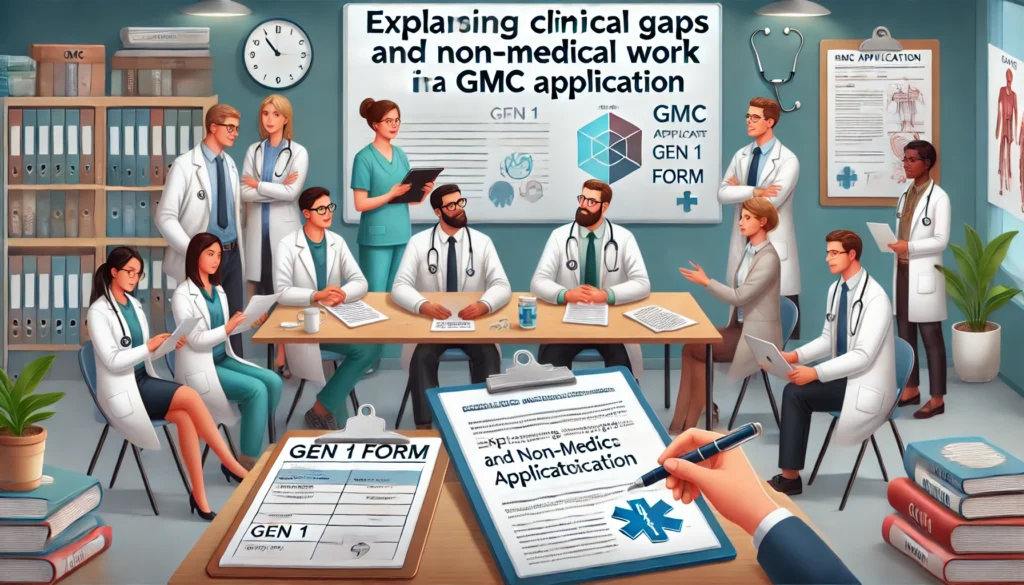Clinical gaps or periods of non-medical work can raise questions during your GMC application. However, you can effectively address these concerns with clear explanations and proper documentation. In this guide, we’ll walk you through acceptable reasons for breaks, how to complete GEN 1 forms , and tips for demonstrating your ongoing fitness to practice. Let’s dive in!
Why Addressing Clinical Gaps Matters
The General Medical Council (GMC) evaluates your application not just on qualifications but also on your fitness to practice . Gaps in clinical practice or non-medical employment can signal potential issues if not explained properly.
- Key Takeaway: Transparency is crucial, honesty builds trust with the GMC.
- Good News: There are acceptable ways to explain gaps and demonstrate your commitment to medicine.
Examples of Acceptable Reasons for Breaks
The GMC understands that life happens. Here are some common and acceptable reasons for clinical gaps:
1. Further Studies
- Pursuing advanced degrees, diplomas, or certifications related to medicine.
- Example: Completing a Master’s in Public Health or a fellowship program.
2. Personal Reasons
- Family responsibilities, health issues, or bereavement.
- Be honest but concise, no need to overshare personal details.
3. Career Breaks
- Taking time off for self-care, travel, or exploring other interests.
- Highlight any activities that contributed to personal growth or skill development.
4. Professional Development
- Attending conferences, workshops, or online courses to stay updated in your field.
5. Non-Medical Employment
- Working in roles unrelated to medicine, such as teaching, research, or administrative jobs.
Pro Tip: Always frame your explanation positively, emphasizing how the break has prepared you to return to medicine stronger.
How to Complete GEN 1 Forms for Non-Medical Employment
If you’ve had non-medical work or clinical gaps in the past five years, you’ll need to submit a GEN 1 Employer Reference Form . Here’s how to handle it:
1. Understand What GMC Needs
- The form confirms your employment history and ensures there are no fitness-to-practice concerns.
- It must be completed by your employer or supervisor.
2. Provide Context
- Include a brief explanation of your role and how it aligns with your career goals.
- Example: “I worked as a medical writer to enhance my understanding of healthcare communication.”
3. Ensure Accuracy
- Double-check dates, job titles, and responsibilities to avoid discrepancies.
4. Use Official Channels
- If your employer doesn’t have an official email, contact the GMC for alternative submission methods (e.g., fax or post).
Important Note: Don’t skip this step; even small gaps must be accounted for.
Tips for Demonstrating Ongoing Fitness to Practice
Even with gaps, you can show the GMC you’re ready to return to clinical practice. Here’s how:
1. Highlight Relevant Activities
- Mention any clinical attachments, volunteer work, or shadowing experiences.
- Example: “I completed a three-month clinical attachment in internal medicine to refresh my skills.”
2. Stay Updated
- Enroll in online courses or webinars to keep your medical knowledge current.
- Platforms like BMJ Learning or FutureLearn offer excellent resources.
3. Obtain References
- Seek letters of recommendation from consultants or supervisors who can vouch for your competence.
4. Address Gaps Proactively
- In your GMC application, include a brief statement explaining how you’ve maintained your clinical skills during the gap.
Pro Tip: Use the UK Medics app to track your professional development and gather evidence of ongoing learning.
Common Scenarios and How to Handle Them
Scenario 1: Long Break from Medicine
- What to Do: Focus on activities that keep you connected to healthcare, such as volunteering or studying.
- Example Statement: “During my two-year break, I volunteered at a local clinic and completed an online course in clinical pharmacology.”
Scenario 2: Non-Medical Work
- What to Do: Emphasize transferable skills like teamwork, leadership, or problem-solving.
- Example Statement: “My role as a project manager honed my organizational skills, which are valuable in clinical settings.”
Scenario 3: Recent Graduates with No Internship
- What to Do: Apply for provisional registration and complete the UK Foundation Programme (UKFP).
Summary of Key Takeaways
- Be Honest: Clearly explain your gaps with acceptable reasons.
- Complete GEN 1 Forms: Ensure Accuracy and provide Context for non-medical work.
- Demonstrate Fitness to Practice: Highlight relevant activities, stay updated, and obtain references.
- Leverage Tools: Use the UK Medics app to organize your evidence and stay on track.
Take Action Today!
Addressing clinical gaps and non-medical work doesn’t have to be stressful. Following these strategies will prepare you to present a strong GMC application.
Now it’s your turn!
- Have you faced challenges explaining gaps in your GMC application? Share your story in the comments below.
- Download the UK Medics app to streamline your GMC preparation and track progress.
- Share this post with fellow IMGs who might find it helpful.
Let’s make your journey to GMC registration smoother and more successful!










